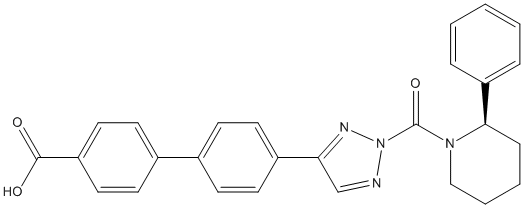Piperidinyl-1,2,3-triazole-urea-inhibitor-2
N1-substituted triazole urea previously disclosed as an inhibitor of ABHD6 KT195 was modified as N2-substituted isomer and shown to inhibit LYPLAL1. The compound 2 inhibited also other alpha/beta hydrolases and some SGNH hydrolase-type esterase (PAFAH1B2-3), but compound 11 and 12 are specific. The adduct in the structure is the small (R)-2-phenylpiperidine-1-carbonyl
General
Type : Piperidine,Urea derivative,Triazol
Chemical_Nomenclature : 4-[4-[2-[(2R)-2-phenylpiperidine-1-carbonyl]triazol-4-yl]phenyl]benzoic acid
Canonical SMILES : C1CCN(C(C1)C2=CC=CC=C2)C(=O)N3N=CC(=N3)C4=CC=C(C=C4)C5=CC=C(C=C5)C(=O)O
InChI : InChI=1S\/C27H24N4O3\/c32-26(33)23-15-11-20(12-16-23)19-9-13-21(14-10-19)24-18-28-31(29-24)27(34)30-17-5-4-8-25(30)22-6-2-1-3-7-22\/h1-3,6-7,9-16,18,25H,4-5,8,17H2,(H,32,33)\/t25-\/m1\/s1
InChIKey : DMGNPPFKBOMVQC-RUZDIDTESA-N
Other name(s) : BDBM195571,(R)-4'-(2-(2-phenylpiperidine-1-carbonyl)-2H-1,2,3-triazol-4-yl)-[1,1'-biphenyl]-4-carboxylic acid (2)
MW : 452.51
Formula : C27H24N4O3
CAS_number :
PubChem : 122172786
UniChem : DMGNPPFKBOMVQC-RUZDIDTESA-N
IUPHAR :
Wikipedia :

Target
Families : Piperidinyl-1,2,3-triazole-urea-inhibitor-2 ligand of proteins in family: LYsophospholipase_carboxylesterase || Carb_B_Chordata || ABHD11-Acetyl_transferase || PAF-Acetylhydrolase || Cholesterol_esterase
Stucture : 5KRE Crystal Structure of human LYLPLAL1 with a covalent inhibitor
Protein : human-LYPLAL1
References (1)
| Title : Discovery of a Selective Covalent Inhibitor of Lysophospholipase-like 1 (LYPLAL1) as a Tool to Evaluate the Role of this Serine Hydrolase in Metabolism - Ahn_2016_ACS.Chem.Biol_11_2529 |
| Author(s) : Ahn K , Boehm M , Brown MF , Calloway J , Che Y , Chen J , Fennell KF , Geoghegan KF , Gilbert AM , Gutierrez JA , Kalgutkar AS , Lanba A , Limberakis C , Magee TV , O'Doherty I , Oliver R , Pabst B , Pandit J , Parris K , Pfefferkorn JA , Rolph TP , Patel R , Schuff B , Shanmugasundaram V , Starr JT , Varghese AH , Vera NB , Vernochet C , Yan J |
| Ref : ACS Chemical Biology , 11 :2529 , 2016 |
| Abstract : Ahn_2016_ACS.Chem.Biol_11_2529 |
| ESTHER : Ahn_2016_ACS.Chem.Biol_11_2529 |
| PubMedSearch : Ahn_2016_ACS.Chem.Biol_11_2529 |
| PubMedID: 27391855 |
| Gene_locus related to this paper: human-LYPLAL1 |